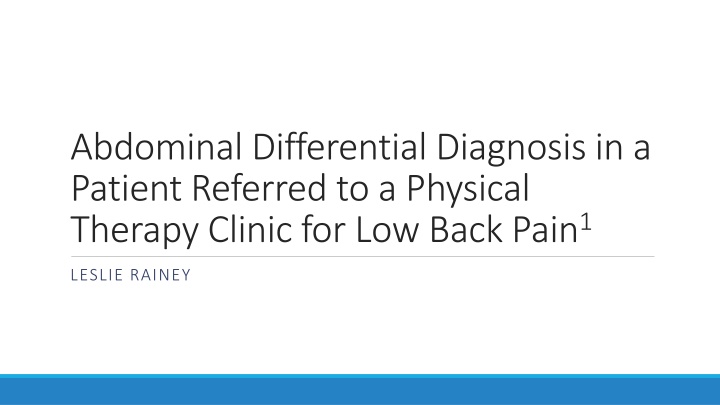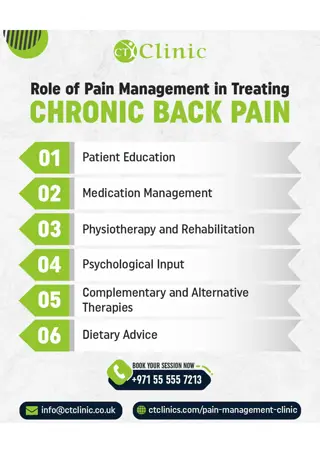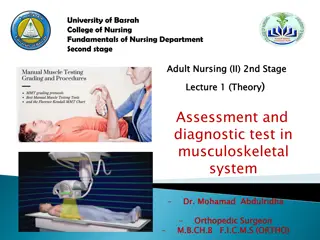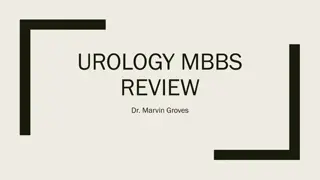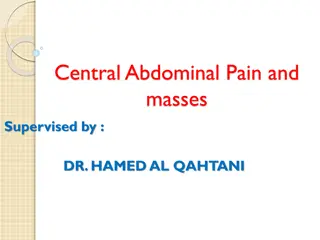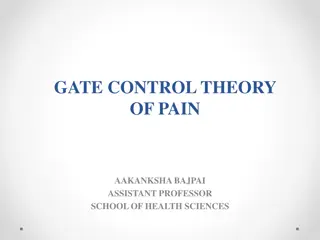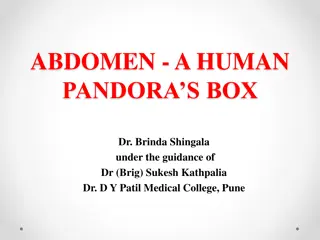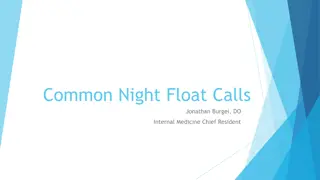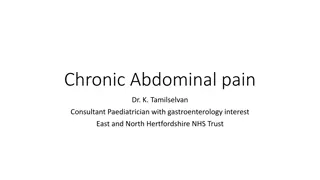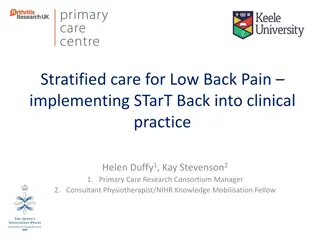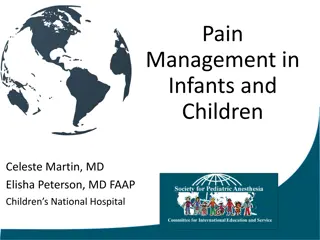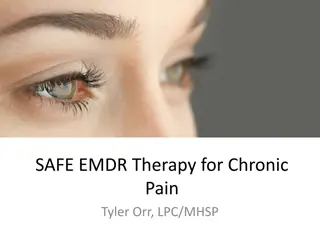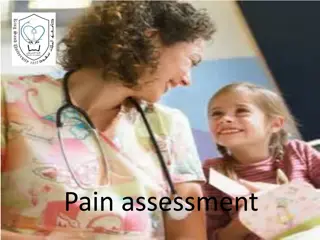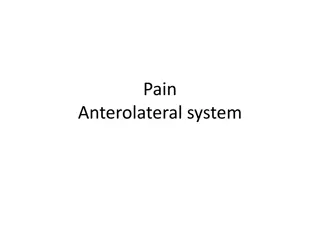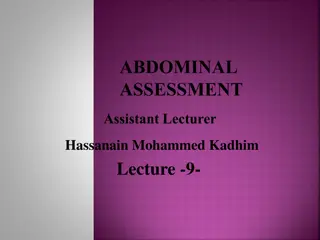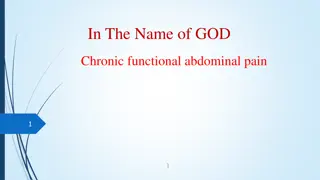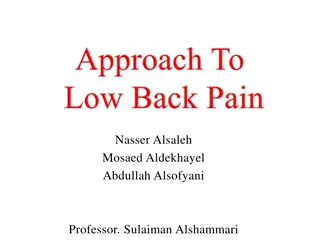Abdominal Differential Diagnosis in a Patient Referred for Low Back Pain
A 67-year-old Caucasian male, retired with back pain, referred for Physical Therapy evaluation after unsuccessful pharmaceutical treatment. History, initial ED visit, and PT evaluation included.
Download Presentation

Please find below an Image/Link to download the presentation.
The content on the website is provided AS IS for your information and personal use only. It may not be sold, licensed, or shared on other websites without obtaining consent from the author.If you encounter any issues during the download, it is possible that the publisher has removed the file from their server.
You are allowed to download the files provided on this website for personal or commercial use, subject to the condition that they are used lawfully. All files are the property of their respective owners.
The content on the website is provided AS IS for your information and personal use only. It may not be sold, licensed, or shared on other websites without obtaining consent from the author.
E N D
Presentation Transcript
Abdominal Differential Diagnosis in a Patient Referred to a Physical Therapy Clinic for Low Back Pain1 LESLIE RAINEY
Patient History 67 yo Caucasian Male 1.8 m (5 10 ) and 92.1kg (~202 lbs) Occupation: Retired from full-time employment, works part-time as a van driver Hobbies: sewing quilts, long-distance traveling by motor home with wife
Initial ED Visit Back pain so severe, pt was transported to ED by ambulance r/o possible cardiopulmonary emergency and/or other visceral pathology Imaging: CT scan negative for aneurysm and bone pathology of lower spine and pelvis Pt was moaning and crying with any form of movement or exam IV morphine diminished pain enough to complete examination procedures Pt d/c home with dx of musculoskeletal back pain and paraspinal spasm, prescription for Vicodin, Flexeril and told to f/u w/ PCP if pain does not subside
Follow-Up PCP visit Pharmaceutical treatment for back pain and continued medical observation After 10 days, pain had not resolved PCP referred patient to PT for evaluation and treatment . What do you want to ask about in subjective history?
PT Evaluation Referral from PCP w/ medical diagnosis of musculoskeletal back pain and paraspinal spasms Observation: Pt in obvious pain, grimacing facial expression, antalgic gait pattern Onset: 2 weeks prior Pain characteristics: diffusely located in lumbar and lower thoracic region, constant Aggs: prolonged sitting and changing positions Eases: pain medication and resting in R sidelying position, slow walking Pain Scale: 10/10 at worst, 2/10 at best, 5/10 currently
PT Evaluation Red Flag Questions: Denies chest, abdomen, LE pain and discomfort, denies recent fever/illness, night pain, or unexplained weight loss, sleep significantly disturbed 2 pain Functional status: ADLs require additional time and assistance from wife, unable to work PMHx: insignificant except for HTN that is controlled with medication PSHx: inguinal hernia repair 16 years ago, laparoscopic cholecystectomy 6 years ago Meds: Zestril (ACE inhibitor, treats HTN), Flexeril (cyclobenzaprine, muscle relaxant), Ultram (tramadol, narcotic) Pt s Goals: resolve low back pain, be physically capable of beginning an extended vacation 3 weeks from now
What Next? Musculoskeletal cause or non-musculoskeletal origin of pain? Continue on with evaluation?
PTs Conclusion After Subjective History Evidence to support MSK cause for sx pain reduced with rest and provoked with specific activity and positional changes Evidence to support non-MSK origin of pain patient s age, night pain disrupting sleep, possibility of psychogenic influence PT decides to continue on and perform physical examination What do you want to test?
Physical Exam Limited by severity of pain Observation: antalgic posture with forward flexion and L lateral shift of the trunk, visibly uncomfortable in prolonged sitting and standing positions, unwilling to lay supine Functional mobility: transfers impaired (sit to stand and walking, required assistance from wife) ROM: significantly limited in all directions secondary to pain Special Tests: (-) slump test (no radicular sx, did provoke back pain) Sensation: LE intact to gross light touch Reflexes: symmetrical, 2+ throughout Myotomes: strong and painless Palpation: painful myofascial trigger points and spasms along paraspinal musculature of lower spine
Modalities 10 minutes of continuous ultrasound at frequency of 1 MHz and intensity of 1.0 W/cm2 Followed by light soft tissue massage to paraspinal musculature Spasms and pain subsided enough for patient to assume supine position What would you do next?
Therapeutic Exercise Single leg knee to chest stretch pain wrapping around the upper abdominal region Iliopsoas test abdominal pathology identified What next? Differential Diagnosis?
Additional Screening Denies chest, neck, jaw or UE pain, pressure or discomfort Denies SOB, difficulty breathing or feeling nauseous No diaphoresis Strong radial pulse Patient reveals he has not had a bowel movement in 3 days and c/o abdominal distension Wife mentions he looked pale to her, attributed it to pain Abdomen screen: palpation in each of the 4 quadrants provoked diffuse pain throughout the right and left upper abdominal quadrants, with apprehensive muscle guarding by patient No gross pulsations or obvious masses noted
Immediate Physician Referral Physician Referral Continue on with PT treatment
Immediate Physician Referral Evidence supporting a systemic origin of patient s pain age, abdominal pain and muscle guarding elicited with palpation, abdominal pain provoked by a therapeutic procedure similar to the iliopsoas test, 3-day history of absent bowel movements PT recommended an immediate referral for a medical evaluation of the abdominal pain by a physician and wife immediately took patient to ED
ED Visit #2 Imaging: abdominal radiographs significant retention of stool in the right colon and lack of stool/air in the descending colon, suggesting possible intestinal obstruction Reviewed CT scan from 2 weeks ago mild small bowel dilation which at the time was not considered significant Working dx: Physician concerned about possible evolving adhesive intestinal obstruction r/o after gastrografin enema visualized with fluoroscopy dilation of the right colon and small bowel dilation but after a few hours, the contrast was visualized in the cecum
Final Diagnosis Patient s abdominal pain/distension was due to severe intestinal constipation as a result of decreased colonic motility secondary to opioid analgesic medications Medical treatment: prevent progression of impaction and to eradicate the transient fecal obstruction by administration of enemas D/c after 12 hours in ED, intestinal sx resolved over the next few days with follow up care from PCP Persistent back pain returned to PT
Subsequent PT Visits Pain improved, allowing improvement in trunk mobility Interventions: modalities, manual therapy techniques, patient education about posture and body mechanics, and therapeutic exercise trunk ROM and lumbar stabilization progressions d/c from PT after 9 visits over 3 weeks
Medication-Induced Gastropathy2 NSAID- related GI complications are the most common drug side effect in the US Bleeding gastric or duodenal ulcers, obstructions, and perforations Caused by the inhibition of mucosal cyclooxygenase-1 (COX- 1) and the suppression of prostaglandin
Risk Factors3 Advanced age (>60 years old) History of peptic ulcer disease Use of other drugs known to damage or exacerbate damage to GI tract (oral corticosteroids, anticoagulants) High doses of or use of multiple NSAIDs or aspirin Serious systemic illness (heart disease, rheumatoid arthritis) Smoking, Alcohol use Renal complications in patients with HTN or CHF Use of acid suppressants NSAIDs + selective serotonin reuptake inhibitors (SSRIs)
Signs and Symptoms3 Can be asymptomatic until advanced stage Nausea, stomach pain, indigestion, heartburn Skin reactions (itching, rash, acne) Increased BP New-onset back or shoulder pain Melena, tinnitus CNS impairment (headache, depression, confusion, memory loss, mood changes) Renal involvement (muscle weakness, fatigue, restless leg syndrome, polyuria)
Strengths and Weaknesses Strengths: Very thorough subjective and objective examination PT considers evidence for both MSK and non-MSK cause of pain throughout the whole eval PT able to identify alarming findings even when not specifically looking for them Weaknesses: CT scan at initial ED visit showed mild small bowel dilation, considered insignificant at time More attention to medications warranted
Relevance to PT4 NSAIDs and other analgesic medications are very commonly seen in patients medication list in Physical Therapy PTs should inquire about dosage, how long patient has been taking meds, and if they are combining OTC and Rx medications Patient education regarding adverse effects of NSAIDs 75% of NSAID users unaware/unconcerned about potential GI complications Be aware of risk factors and sx of medication-induced GI complications Do not be afraid to ask the uncomfortable questions!
Sources 1. referred to a physical therapy clinic for low back pain. J Orthop Sports Phys Ther 2005;35(11):755-764. doi:10.2519/jospt.2005.35.11.755. Stowell T, Cioffredi W, Greiner A, Cleland J. Abdominal differential diagnosis in a patient 2. review of risk factors and preventative strategies. Drug Healthc. Patient Saf. 2015;7:31-41. doi:10.2147/DHPS.S71976. Goldstein JL, Cryer B. Gastrointestinal injury associated with NSAID use: a case study and 3. Catherine C. Goodman MBA PT CBP. Differential Diagnosis for Physical Therapists: Screening for Referral. 6th ed. (Heick J, Lazaro RT, eds.). Saunders; 2017. 4. gastrointestinal complications in individuals receiving outpatient physical therapy services. J Orthop Sports Phys Ther 2002;32(10):510-517. doi:10.2519/jospt.2002.32.10.510. Boissonnault WG, Meek PD. Risk factors for anti-inflammatory-drug- or aspirin-induced
